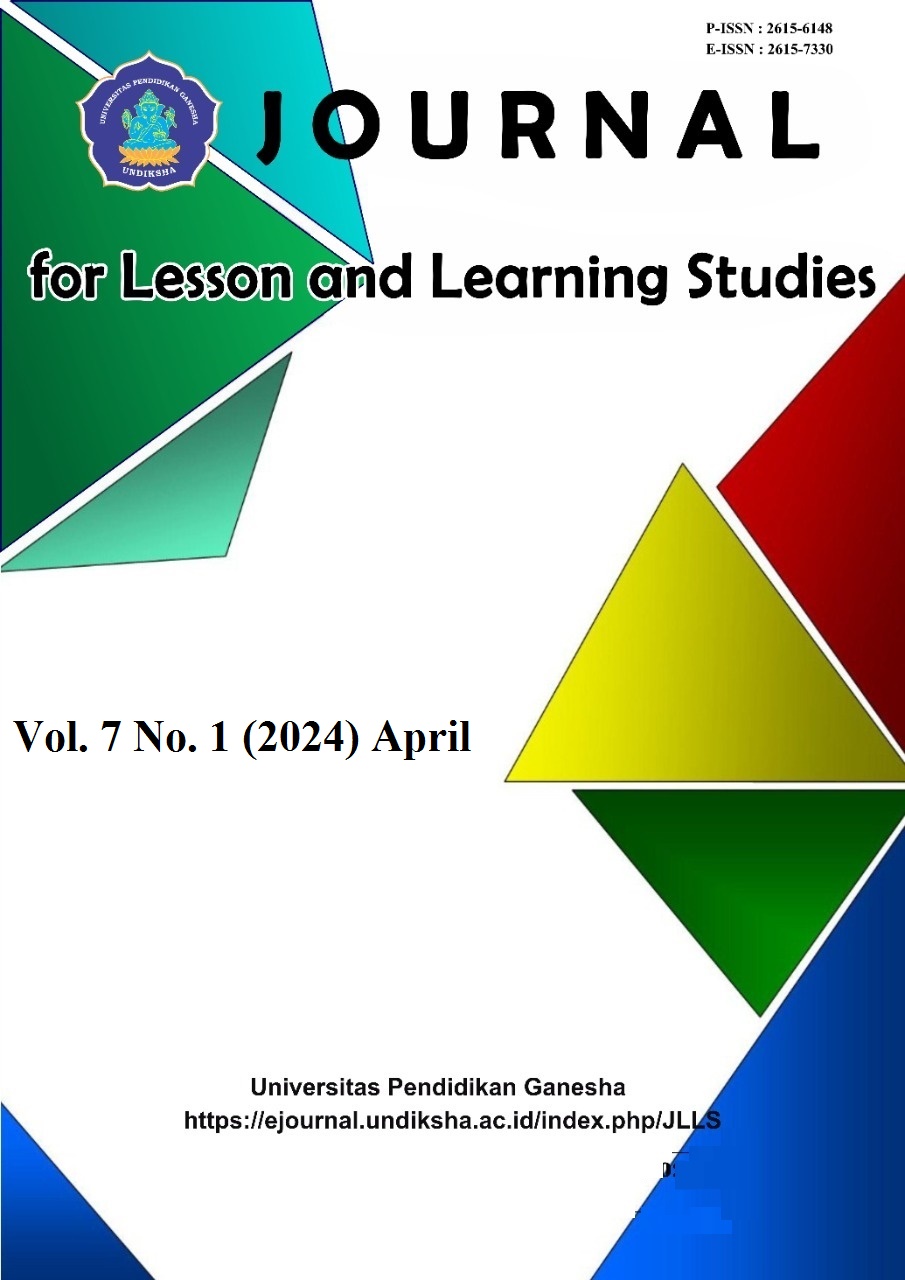Innovative Learning Media: Ethnomathematics-based Modules for Third-Grade of Elementary School Students
DOI:
https://doi.org/10.23887/jlls.v7i1.68306Kata Kunci:
Module, ethnomathematics, flat shapes, elementary schoolAbstrak
Low learning outcomes on the properties of flat shapes for grade three elementary school students are indicated due to the unavailability of adequate modules. Meanwhile, third-grade students find it easier to learn math through cultural sites as a form of ethnomathematics. This study aims to develop an ethnomathematics-based module that is valid, practical, and effective in improving the learning outcomes of third-grade students on the material properties of flat shapes. This study uses the research and development method through the stages of analysis, design, development, implementation, and evaluation (ADDIE). The subjects of this study were 22 third-grade elementary school students. The validity of the module was measured through validator assessment using a validation questionnaire. The practicality of the module was measured using a student response questionnaire. Effectiveness was measured by comparing pre-test and post-test scores. Data collection techniques used questionnaires and tests. The validity results obtained an average value of 1 in the interval 0.80-1,00 with very valid criteria. Practicality obtained a value of 94% in the interval 85.01%-100% with very practical criteria. Effectiveness obtained a significance value of 0.000<0.05, which can improve student learning outcomes. Hence, the implication of the results of this development research is to provide a model or example of valid, practical, and effective ethnomathematics-based modules to improve the learning outcomes of third-grade students on the properties of flat shapes material.
Referensi
Aiken, L. R. (1985). Three coefficients for analyzing the realibility and validity of ratings. Educational and Psychological Measurement, 45(1), 131–142. https://doi.org/10.1177/0013164485451012. DOI: https://doi.org/10.1177/0013164485451012
Ambayon, C. M. (2020). Modular-based approach and students’ achievement in literature. International Journal of Education and Literacy Studies, 8(3), 32. https://doi.org/10.7575/aiac.ijels.v.8n.3p.32. DOI: https://doi.org/10.7575/aiac.ijels.v.8n.3p.32
Andriah, A., & Amir, M. F. (2021). Mobile learning based on procedural and conceptual knowledge on fractional for elementary school. Jurnal Ilmiah Sekolah Dasar, 5(4), 567. https://doi.org/10.23887/jisd.v5i4.40819. DOI: https://doi.org/10.23887/jisd.v5i4.40819
Andriani, D., Sahono, B., Badeni, & Haji, S. (2023). RME teaching materials based on Bengkulu etnomatics in mathematics lessons for class IV elementary school. Proceedings of the 3rd International Conference on Educational Science and Teacher Profession (ICETeP 2021), 1, 108–113. https://doi.org/10.2991/978-2-494069-19-0. DOI: https://doi.org/10.2991/978-2-494069-19-0_13
Beltran, R. S. (2021). Effectiveness of modular and video lessons in mathematics to the performance of grade 5 pupils. International Journal of Advanced Multidisciplinary Studies, 1(4), 202–211. https://www.ijams-bbp.net/wp-content/uploads/2021/12/IJAMS-December.
Busrah, Z., & Pathuddin, H. (2021). Ethnomathematics : Modelling the volume of solid of revolution at Buginese and Makassarese traditional foods. JRAMathEdu: Journal of Research and Advances in Mathematics Education, 6(4), 331–351. https://doi.org/10.23917/jramathedu.v6i4.15050. DOI: https://doi.org/10.23917/jramathedu.v6i4.15050
Cai, J., Morris, A., Hwang, S., Hohensee, C., Robison, V., & Hiebert, J. (2017). Improving the Impact of Educational Research. Journal for Research in Mathematics Education JRME, 48(1), 2–6. https://doi.org/10.5951/jresematheduc.48.1.0002. DOI: https://doi.org/10.5951/jresematheduc.48.1.0002
Cortes, D. P. de O., & Orey, D. C. (2020). Connecting ethnomathematics and modelling: A mixed methods study to understand the dialogic approach of ethnomodelling. Revemop, 2(11), 1–25. DOI: https://doi.org/10.33532/revemop.e202011
Cortes, G. M. S., Sortones, B. G. A., Alo, J. A., Capuno, R. G., Manguilimotan, R. P., Espina, R. C., & Padillo, G. G. (2022). A five-pronged evaluation in the crafting of a self-learning module in general mathematics : A case in the Philippines. Journal of Positive School Psychology, 6(11), 1794–1808. https://www.repositorio.ufop.br/handle/123456789/14502.
Faiziyah, N., Khoirunnisa, M., Azizah, N. Nu., Nurrois, M., Prayitno, H. J., Desvian, Rustamaji, & Warsito. (2021). Ethnomathematics: Mathematics in Batik Solo. In Journal of Physics: Conference Series. IOP Publishing Ltd, 1720(1). https://doi.org/10.1088/1742-6596/1720/1/012013. DOI: https://doi.org/10.1088/1742-6596/1720/1/012013
Febriyanti, D. A., & Ain, S. Q. (2021). Pengembangan Modul Matematika Berbasis Etnomatematika Pada Materi Bangun Datar di Sekolah Dasar. Jurnal Basicedu, 5(3), 1409–1417. https://doi.org/10.31004/basicedu.v5i3.933. DOI: https://doi.org/10.31004/basicedu.v5i3.933
Florentino, M., Lukito, A., & Mariana, N. (2022). Pengembangan modul pembelajaran geometri berbasis etnomatematika di kelas V. EDUKASIA: Jurnal Pendidikan Dan Pembelajaran, 3, 949–958. https://doi.org/10.62775/edukasia.v3i3.220. DOI: https://doi.org/10.62775/edukasia.v3i3.220
Fouze, A. Q., & Amit, M. (2021). Teaching geometry by integrating ethnomathematics of bedouin values. Creative Education, 12, 402–421. https://doi.org/10.4236/ce.2021.122029. DOI: https://doi.org/10.4236/ce.2021.122029
Fouze, A. Q., & Amit, M. (2023). The Importance of ethnomathematics education. Creative Education, 14, 729–740. https://doi.org/10.4236/ce.2023.144048. DOI: https://doi.org/10.4236/ce.2023.144048
Hariastuti, R. M., Budiarto, M. M. T., & Manuharawati. (2022). Combining ethnomathematics, thematics, and connectedness in a mathematics learning model for elementary school. Specialusis Ugdymas, 1(43), 9462–9486. http://sumc.lt/index.php/se/article/view/1441.
Hwang, W. Y., Hoang, A., & Tu, Y. H. (2020). Exploring authentic contexts with ubiquitous geometry to facilitate elementary school students’ geometry learning. Asia-Pacific Education Researcher, 29(3), 269–283. https://doi.org/10.1007/s40299-019-00476-y. DOI: https://doi.org/10.1007/s40299-019-00476-y
Iswara, H. S., Ahmadi, F., & Ary, D. Da. (2022). Numeracy Literacy Skills of Elementary School Students through Ethnomathematics-Based Problem Solving. Interdisciplinary Social Studies, 2(2), 1604–1616. https://doi.org/10.55324/iss.v2i2.316. DOI: https://doi.org/10.55324/iss.v2i2.316
Janiola, F. R., & Santos, M. S. M. D. L. (2021). The ethnomathematics practices of Eskaya Tribe. TURCOMAT: Turkish Journal of Computer and Mathematics Education, 12(3), 3767–3777. https://doi.org/10.17762/turcomat.v12i3.1660. DOI: https://doi.org/10.17762/turcomat.v12i3.1660
Johnson, J. D., Smail, L., Corey, D., & Jarrah Adeeb M. (2022). Using bayesian networks to provide educational implications : Mobile learning and ethnomathematics to improve sustainability in mathematics education. Sustainability, 14(5897), 1–20. https://doi.org/10.3390/su14105897. DOI: https://doi.org/10.3390/su14105897
Khair, S., Kartono, K., & Susilaningsih, E. (2023). Development of Lombok culture-based ethnomathematics module to improve mathematical literacy of class IV elementary school students. International Journal of Research and Review, 10(3), 249–257. https://doi.org/10.52403/ijrr.20230327. DOI: https://doi.org/10.52403/ijrr.20230327
Leon, N. G. De. (2023). Localized traditional learning modules in the history of mathematics its effect to the learning competency of students. Journal for Educators, Teachers and Trainers, 14(2), 557–566. https://doi.org/10.47750/jett.2023.14.02.050. DOI: https://doi.org/10.47750/jett.2023.14.02.050
Lestari, D. K. T., Suarjana, I. M., & Paramita, M. V. A. (2023). Miniature media characterized by ethnomathematics in improving mathematics abilities for third grade elementary schools. Jurnal Pendidikan Multikultural Indonesia, 6(1), 1–13. https://doi.org/10.23887/jpmu.v6i1.62099. DOI: https://doi.org/10.23887/jpmu.v6i1.62099
Machaba, F., & Dhlamini, J. (2021). Ethnomathematics as a fundamental teaching approach. In K. Luneta (Ed.), Mathematics teaching and professional learning in sub-Sahara Africa, research in mathematics education (1st ed., Issue March, pp. 59–76). Springer Cham. https://doi.org/10.1007/978-3-030-82723-6_5. DOI: https://doi.org/10.1007/978-3-030-82723-6_5
Madrazo, A. L., & Dio, R. V. (2020). Contextualized learning modules in bridging students’ learning gaps in calculus with analytic geometry through independent learning. Journal on Mathematics Education, 11(3), 457–476. https://doi.org/10.22342/jme.11.3.12456.457-476. DOI: https://doi.org/10.22342/jme.11.3.12456.457-476
Monteleone, C., White, P., & Geiger, V. (2018). Defining the Characteristics of Critical Mathematical Thinking. Annual Meeting of the Mathematics Education Research Group of Australasia, July, 559–566. https://ojs.lib.buu.ac.th/index.php/education2/article/view/7040.
Musser, G. L., Peterson, B. E., & Burger, W. F. (2011). Mathematics For Elementary Teachers. National Council of Teachers of Mathematics.
Nabila, A. S., & Amir, M. F. (2022). Constructivist-based powtoon animation multimedia on simple fractions. Jurnal Pendidikan Dan Pengajaran, 55(2), 250–261. https://doi.org/10.23887/jpp.v55i2.47037.
Natividad, E. D. (2021). Perceived effectiveness of self learning modules in the implementation of modular distance learning in the elementary level. SSRN Electronic Journal, 1–84. https://doi.org/10.2139/ssrn.3889429. DOI: https://doi.org/10.2139/ssrn.3889429
Navarro, M. L. P., Nieto, C. A. R., & Araque, A. M. P. (2022). Ethnomathematical connections in bricks making in Salamina-Magdalena, Colombia, and geometric treatment with GeoGebra. TURCOMAT: Turkish Journal of Computer and Mathematics Education, 13(03), 257–273. https://doi.org/10.17762/turcomat.v13i03.12953.
Oco, R. M. (2022). Learners’ learning, performance, and appreciation towards teacher made math modules with across curriculum integration. GSJ: Global Scientific Journals, 10(5), 2468–2476. https://www.researchgate.net/profile/richard-oco/publication/361177473. DOI: https://doi.org/10.18535/ijsrm/v10i8.el01
Orey, D. C., & Rosa, M. (2020). Connecting ethnomathematics to the concept of positive deviance. Journal of Transformative Praxis, 1(1), 25–35. https://doi.org/10.3126/jrtp.v1i1.31758. DOI: https://doi.org/10.3126/jrtp.v1i1.31758
Peterson, C. (2003). Bringing ADDIE to life: instructional design at its best - learning & technology library (LearnTechLib). Journal of Educatioanal Multimedia and Hypermedia, 12(3), 227–241. https://www.learntechlib.org/primary/p/2074/.
Prahmana, R. C. I., & D’Ambrosio, U. (2020). Learning geometry and values from patterns: Ethnomathematics on the batik patterns of yogyakarta, indonesia. Journal on Mathematics Education, 11(3), 439–456. https://doi.org/10.22342/jme.11.3.12949.439-456. DOI: https://doi.org/10.22342/jme.11.3.12949.439-456
Priyani, N. E. (2021). Pengembangan Modul Etnomatematika Berbasis Budaya Dayak Dalam Pembelajaran Matematika Dengan Pendekatanjoyfull Learning. Didaktika Pendidikan Dasar, 5. https://doi.org/10.26811/didaktika.v5i1.226. DOI: https://doi.org/10.26811/didaktika.v5i1.226
Rezeki, S, Andrian, D., Wahyuni, A., & Nurkholisah, H. (2020). The sustainability concept of Riau cultures through development of mathematics learning devices based on Riau folklore at elementary schools. In Journal of Physics: Conference Series. Institute of Physics Publishing., 1538(1). https://doi.org/10.1088/1742-6596/1538/1/012066. DOI: https://doi.org/10.1088/1742-6596/1538/1/012066
Rezeki, Sri, Andrian, D., & Safitri, Y. (2021). Mathematics and cultures: A new concept in maintaining cultures through the development of learning devices. International Journal of Instruction, 14(3), 375–392. https://doi.org/10.29333/iji.2021.14322a. DOI: https://doi.org/10.29333/iji.2021.14322a
Schoevers, E. M., Leseman, P. P., & Kroesbergen, E. H. (2020). Enriching mathematics education with visual arts: Effects on elementary school students’ ability in geometry and visual arts. International Journal of Science and Mathematics Education, 18, 1613–1634. https://doi.org/10.1007/s10763-019-10018-z. DOI: https://doi.org/10.1007/s10763-019-10018-z
Shahbari, J. A., & Daher, W. (2020). Learning congruent triangles through ethnomathematics: The case of students with difficulties in mathematics. Applied Sciences, 10(4950), 1–20. https://doi.org/10.3390/app10144950. DOI: https://doi.org/10.3390/app10144950
Triwahyuningtyas, D., Mahmuda, N. E., & Ardila, A. (2022). E-module of cube and cuboid based on ethnomathematics for five-grade elementary school students. JTAM: Jurnal Teori Dan Aplikasi Matematika, 6(3), 544. https://doi.org/10.31764/jtam.v6i3.8434. DOI: https://doi.org/10.31764/jtam.v6i3.8434
Triwahyuningtyas, D., Mahmuda, N. E., & Yulianti, Y. (2020). Developing module for two-dimensional course based on ethnomathematics for fourth grade of elementary school student. Al Ibtida: Jurnal Pendidikan Guru MI, 7(2), 166. https://doi.org/10.24235/al.ibtida.snj.v7i2.6314. DOI: https://doi.org/10.24235/al.ibtida.snj.v7i2.6314
Triyanto, A. T., & Aryani, I. K. (2022). Increasing learning motivation and learning outcomes in mathematics using modules for elementary school students. DINAMIKA Jurnal Ilmiah Pendidikan Dasar, 14(1). http://jurnalnasional.ump.ac.id/index.php/Dinamika/article/view/11541. DOI: https://doi.org/10.30595/dinamika.v14i1.11541
Umbara, U., Wahyudin, W., & Prabawanto, S. (2021). Exploring ethnomathematics with ethnomodeling methodological approach: How does Cigugur indigenous people using calculations to determine good day to build houses. Eurasia Journal of Mathematics, Science and Technology Education, 17(2), 1–19. https://doi.org/10.29333/EJMSTE/9673. DOI: https://doi.org/10.29333/ejmste/9673
Utami, N. W., Sayuti, S. A., & Jailani, J. (2021). Indigenous artifacts from remote areas, used to design a lesson plan for preservice math teachers regarding sustainable education. Heliyon, 7(3), e06417. https://doi.org/10.1016/j.heliyon.2021.e06417. DOI: https://doi.org/10.1016/j.heliyon.2021.e06417
Wittmann, E. C. (2021). Connecting mathematics and mathematics education. In Connecting Mathematics and Mathematics Education. Springer International Publishing. https://doi.org/10.1007/978-3-030-61570-3. DOI: https://doi.org/10.1007/978-3-030-61570-3
Wulandari, A., & Amir, M. F. (2021). Mobile game for equality of fractions for elementary school students. International Journal of Elementary Education, 5(4), 525–536. https://doi.org/10.23887/ijee.v5i4.41076. DOI: https://doi.org/10.23887/ijee.v5i4.41076
Yuliana, Y., Usodo, B., & Riyadi, R. (2023). The New Way Improve Mathematical Literacy in Elementary School: Ethnomathematics Module with Realistic Mathematics Education. AL-ISHLAH: Jurnal Pendidikan, 15(1), 33–44. https://doi.org/10.35445/alishlah.v15i1.2591. DOI: https://doi.org/10.35445/alishlah.v15i1.2591
Zhang, C., Wijaya, T. T., Zhou, Y., Chen, J., & Ning, Y. (2021). Ethnomathematics values in Temple of Heaven: An imperial sacrificial altar in Beijing, China. Journal of Physics: Conference Series, 2084(1). https://doi.org/10.1088/1742-6596/2084/1/012015. DOI: https://doi.org/10.1088/1742-6596/2084/1/012015
Unduhan
Diterbitkan
Cara Mengutip
Terbitan
Bagian
Lisensi
Hak Cipta (c) 2024 Miftakhul Masruroh, Mohammad Faizal Amir

Artikel ini berlisensiCreative Commons Attribution-ShareAlike 4.0 International License.
Authors who publish with the Journal for Lesson and Learning Studies agree to the following terms:
- Authors retain copyright and grant the journal the right of first publication with the work simultaneously licensed under a Creative Commons Attribution License (CC BY-SA 4.0) that allows others to share the work with an acknowledgment of the work's authorship and initial publication in this journal.
- Authors are able to enter into separate, additional contractual arrangements for the non-exclusive distribution of the journal's published version of the work (e.g., post it to an institutional repository or publish it in a book), with an acknowledgment of its initial publication in this journal.
- Authors are permitted and encouraged to post their work online (e.g., in institutional repositories or on their website) prior to and during the submission process, as it can lead to productive exchanges, as well as earlier and greater citation of published work. (See The Effect of Open Access)




